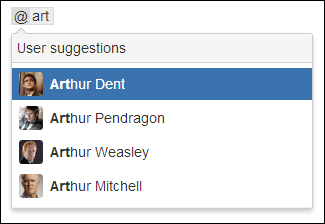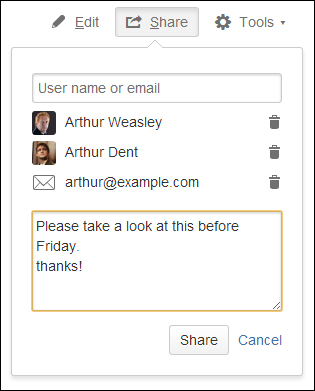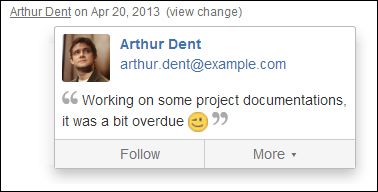Collaborating with other people
Confluence is a great tool for collaboration, but how do you use Confluence to collaborate with others? Imagine that you just wrote a great post, and you want somebody to review it before publishing it, or you just had a meeting and want some people to take actions based on that meeting.
The most important thing for collaboration is the availability of content, and in Confluence all the content is, by default, available for all the users. The next thing is to get people involved, and Confluence offers us several methods for doing exactly that.
Mentions are a great way of getting people to participate in building useful and relevant content. You can mention a person in a special way that will trigger Confluence to send that person a notification. This is called an @mention. The @mention notifications work on pages, blog posts, and comments.
Confluence will send an e-mail message to users letting them know that they have been mentioned in that page. This message is sent when you save the page but only if the mentioned person has view permissions for that page.
Perform the following steps using autocomplete to mention someone:
- Open a page in the edit mode and place your cursor at the location where you want to add a mention.
- Type
@and then the first few characters of the user's full name. - Choose the user's name from the list of suggestions.

It is also possible to add a mention via the editor toolbar, as follows:
- Open a page in the edit mode and place your cursor at the location where you want to add a mention.
- Choose Insert | User mention. Confluence will add an
@sign to the page. - Start typing the person's full name.
- Choose the user's name from the list.
Note that mentions work on a user's full name and not on usernames. It is currently not possible to mention groups.
The @mention notifications are a great way of involving people in your conversation or content. For example, if you want Arthur Dent to take a look at some requirement, just mention him in a comment to get him involved. Don't try to spam people you want to collaborate with; use the mentions sparingly. Another way to get people involved is by sharing your content.
Confluence provides a number of ways for you to share content with other users. The previously discussed Mentions are one of them, but you can also share a page link directly to one or more users, including a brief note about what you expect them to do with the link.
Sharing content via the Share button is only available if a Confluence administrator has configured a mail server.
To e-mail a link using the Share button, perform the following steps:
- Go to the page or blog post you want to share.
- Click on Share at the top right. Enter the name or username of a Confluence user or use a valid e-mail address. As you start typing, a suggestion list will appear.
- Select the appropriate user or e-mail address from the list. You can add multiple recipients and combine both usernames and e-mail addresses.
- Enter an optional message into the Note box.
- Click on Share to send the link via e-mail.

When you are reading a good blog post or page on Confluence, you can let other users know this by liking a page. Confluence has a like button on every page, blog post, and comment.
Likes are also being used for populating the Popular Content tab on the dashboard and the Recommended Updates e-mail.
Click on the Like button to let people know you agreed with or enjoyed the content or comment. Your name will be added to the list of other people who already liked the same content. Clicking on the Unlike button will remove you from the list.
When you like a page, blog post, or comment:
- The author of the content receives a notification
- People in your network receive a notification, unless they already know of the content, meaning:
- Somebody else in their network already liked the content
- The user himself already liked the content
- The user already commented on the content or replied to a comment
- If enough people like the content, it will appear on the Popular Content tab on the dashboard
- If enough people like the content, it will be included in the Recommended Updates e-mail
The Like functionality is provided by a plugin called Confluence Like Plugin and can be disabled in the Administration Console | Manage Add-ons. This will disable the functionality on a site-wide basis. It isn't possible to disable on a space or page basis. You can find more information on managing add-ons in Chapter 9, General Administration.
Status updates are short messages broadcasted to the different activity streams in Confluence. Such a short message could include:
- A description about what you are working on
- An interesting link or fact you want to share
- A question you may want to be answered quickly
The history of your status updates is available in a Status updates view, while the current status message is shown on your profile and profile hover.

- Make sure you are logged in to Confluence.
- Click on your avatar in the top-right corner and choose Update Status… from the drop-down menu.
- Enter a short message (max 140 characters) that describes your current status or the content you want to share.
- Click on Update to publish your new status.

Once you have updated your status, you can easily view, clear, or remove them if you have made a mistake. Editing a status update is not possible.
To view your status updates, perform the following steps:
- Click on your avatar at the top-right corner.
- Select Status Updates from the drop-down menu.
It is also possible to view another user's status by going to their profile.
To clear your current status, perform the following steps:
- Go to the Status Updates view in your user profile.
- Click on Clear below the top status update.
Clearing your status isn't the same as deleting it. If you clear your status, it doesn't show in your profile or profile hover, but it will still be visible on the Status Updates view.
To delete a status update, perform the following steps:
Normally, status updates are only displayed on a user profile or in the recently updated content on the dashboard. A great way to make more use of status updates is to use the recently-updated macro to display the updates on a page.
To insert status updates in a page:
- Open a page in the edit mode or create a new page.
- Use the shortcut { (Shift + [) or Insert | Other Macros to select the recently Updated macro.
- Open the macro's property panel by clicking on the macro container and selecting Edit.
- In order to display only status updates, fill in the following properties:
- Space(s): @all
- Include these Content Types Only: Status
- Show User Profile Pictures: Checked
- Click on Save and save the page.
You can also place the macro inside a panel to make it stand out a bit from the other content. This is shown in the following screenshot:

